The rapid growth of algae is always a sign that the biological balance of the aquarium has been disturbed. The main causes are poor water quality, ill-fitting conditions, lack of micro and macro fertilizer elements. Algae mangers play a very important role in our aquarium for a balance in the ecosystem. The most effective way to use these aids is to add different types of algae to the aquarium.
A combination of snails, shrimp, and fish is the best. Fighting with algae is our daily concern. It is a major responsibility. The Chinese algae eater is a species of freshwater fish widespread in the waters of the rivers and lakes in Thailand. He prefers clean, flowing waters and stays in areas heavily populated by vegetation.
Table of Contents
Overview Of Chinese Algae Eater
| Scientific Name: | Gyrinocheilus aymonieri |
| Common Name: | Chinese algae eater, sucking loach, honey sucker, sucking catfish |
| Distribution: | Laos, Vietnam, Thailand |
| Size: | 5–7 inches |
| Life expectancy: | 7–10 years |
| Colour: | Pale brown with black stripes or spots |
| Diet: | Omnivore, algae, tropical flakes, worms, brine shrimp, daphnia |
| Temperament: | Semi-aggressive |
| Minimum tank size: | 50 gallons |
| Temperature: | 72–82°F (22–28°C) |
| pH: | 6.8–7.4 |
| Hardness: | 5–19 dGH |
| Care level: | Easy |
| Breeding: | Egg layer |
| Activity: | Natural loner, bottom-dwelling forager |
| Compatibility: | Shows semi-aggressive behavior towards the similar species |
Chinese Algae Eater Natural Habitat and Origin
The source from where algae originate is warm lakes and flowing rivers with substrates like sand, vegetation, and driftwood. In the rainy season, the habitats will be flooded and muddy. Based on its name, it is seen in China and found in rivers and streams of Thailand, Vietnam, and Laos.
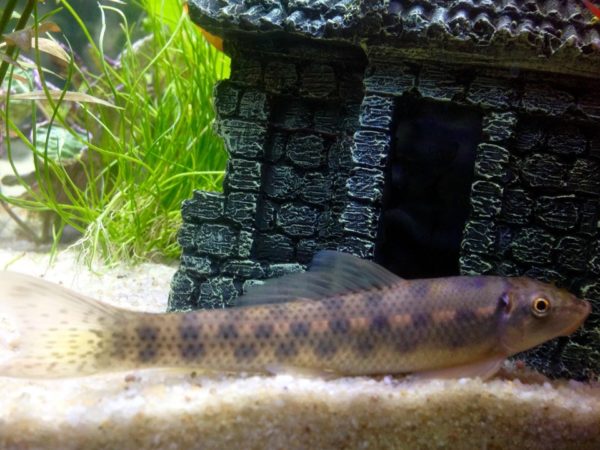
Chinese Algae Eater Size
The Chinese Algae eaters will grow up to 11 inches long and about 5 to 7 inches in length.
Chinese Algae Eater Lifespan
If properly cared for, the lifespan of the species will be 5 to 10 years.
Chinese Algae Eater Availability
The Chinese Algae eaters are mostly available in aquarium stores as tank cleaners. The cost of it is nearly $4 to $6.
You can purchase the algae in online stores.
Chinese Algae Eater Behavior And Appearance
This fish species has an elongated body, with a yellowish color, mustard, light brown on the back, and white on the ventral side. On the dorsal side, it has all sorts of small black spots starting from the bot to the base of the tail. There are no spots on the ventral side. At the top of the bronchi is a black, round, well-shaped skull. On the sides, on the median area, he has a small pattern of small spots, arranged in a zigzag form, starting from the eye area and ending at the base of the tail. Compared to the rest of the body, it has an elongated butt that ends with a large mouth and protruding and excessively large lips.
The Chinese algae eater is considered one of the best fish to combat algae in the aquarium because of the constant appetite for “green”, the very peaceful behavior towards both fellow humans and other fish, lack of appetite for plants and relatively small dimensions.
CAEs are sociable fish and prefer groups of at least 5-6 individuals. They are energetic swimmers and need a large pool and a medium to very large plant density. They are very good fish for common aquariums, being peaceful even with small fish or shrimp species. He prefers very clear water to be sensitive to soil suspensions in water.
The swimmers are transparent with a yellow tint in the thorn area. The tail has the same color, but it is also sprinkled with small black spots. It has a V-shaped tail, very little accentuated. His eyes are black, with an annular, adjacent, golden area followed by another black one. There is also an albino variety of this species of fish.
Sex Differentiation
At the time of mating, male Chinese algae eaters develop horns on their noses.
Chinese Algae Eater Care
Taking care of the Chinese Algae Eater is very easy. The tank should be properly maintained to prevent stress and diseases of the Chinese Algae Eater.
Chinese Algae Eater Natural Habitat
The Chinese Algae eaters grow well in fast-flowing rivers and streams in south Asia. The fish swim down the sandy, stony riverbed, clinging to food objects and avoiding being dragged along by the flow. Chinese algae eaters migrate to flooded environments with murky waters depending on the season.
Chinese Algae Eater Care & Tank Set-Up
A Chinese Algae eater requires a rank of a minimum of 50 gallons. Preferably, a rectangular tank that offers ample space will be a good option.
Because it is quite similar to a sandy riverbed in the environment look and feel, sand or gravel will be a great substrate for a Chinese algae eater’s tank. Sand is the greatest choice because it will not scratch the fish.
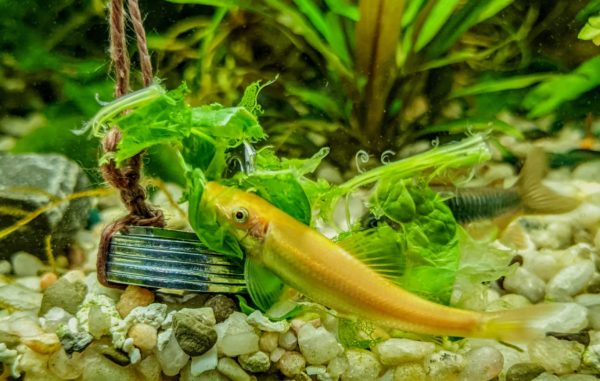
Chinese algae eaters can flee to caves and rocks when stressed or need to relax. You should always ensure ample space for the Chinese algae eater as it likes to have its territory in the aquarium. This further prevents stress and any territorial behavior.
Live plants provide additional protection and aid in the maintenance of the tank. Deep-rooted plants like anubias and Java fern are ideal for a Chinese algae eater tank. You can also add artificial plants made of silk or plastic as additional surfaces for algae growth.
Chinese Algae Eater Tank Size and Specifications
For good maintenance of these fish, you need an aquarium with a minimum volume of about 210 liters with a water temperature of between 24 and 28 ° C and a pH whose values do not exceed 6 – 8.5. They are a species of fish that can adapt to any environment.
Being a species of terrible and very aggressive fish over other specimens of its species, it is not advisable to keep more than one such fish at a volume of water of at least 100 liters. Some specimens, much older and much larger, are recognized as terrorizing an entire aquarium of fish. At maturity, a specimen of this species reaches a length of about 27 cm. The price of one piece of broiler varies between 2 – 3 euros, depending on the size, provenance, and the shop where it is purchased.
In brief, the tank conditions should be as follows
- Water type: Fresh Flowing water
- Size of the tank: Min 50 gallons
- Temperature of water: 72-82 °F
- Substrate: Gravel or Sand
- Tank Setup: Caves, hollow decorations, Artificial plants
- Acidity: 6.8-7.4 pH
- Hardness of water: 5-19 dGH
- Filter: Required
- Pump: Not mandatory, but can be used to make the current stronger
- Bubbler: Not required
- Lightning: Required to promote the growth of the plants
- Water heater: Required to maintain the desired temperature in the water.
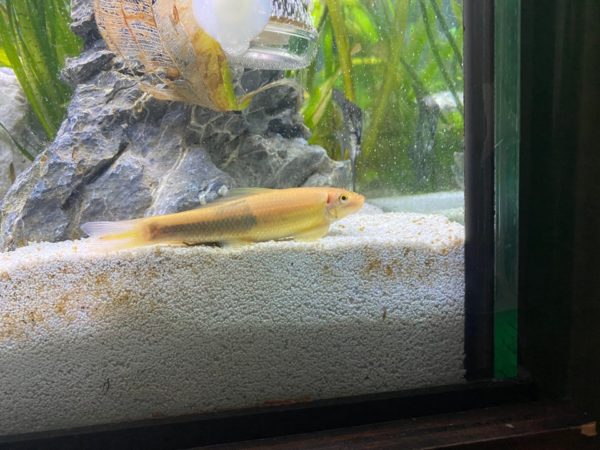
Setting Up A Chinese Algae Eater Tank
- The tank should be cleaned and rinsed well to remove dust particles. Once the tank is cleaned, place the substrate to a depth of 2 to 3 inches.
- Place the heater and filter in the tank.
- On the sand or gravel, set an upturned dish. Fill your tank with tap water, carefully pouring it over the dish to avoid disturbing the substrate. Do not use a water conditioner for cycling the tank before adding your fish.
- Ammonia is present in untreated tap water, which is required to start the nitrogen cycle and get your biological filter to perform properly.
- Place the decorative in the tank after rinsing them to remove the dust.
- Plants with broken stems, dead leaves, or straggly growth should be trimmed and added to the tank. Remember to give plenty of room on the substrate for the Algae Eaters to swim.
- Before adding your fish, keep the filtration system and heater on for at least 10 days.
- Test the water to ensure it doesn’t contain any ammonia or nitrites before putting your livestock in it. You can expect low nitrate levels, but that is alright until it exceeds 20 parts per million (ppm).
Chinese Algae Eater Common Diseases and their Treatment
Health
The Chinese Algae eaters’ belly is scaleless, so it can easily be prone to diseases. Also, Chinese algae eaters are pretty sensitive to fish medications. Hence the affected fishes should be treated in a separate tank.
Good Health Symptoms
The Chinese Algae eaters will swim actively by consuming algae. These species will always be curious in search of new algae to eat. Continuous and Active swimming is a sign of good health.
Bad Health Signs
If the species’ health is disturbed, it will alert us by a few signs
- Appetite loss – It will not consume algae at all
- By settling at the bottom of the tank
- No active swimming
- swelling
- Ripped fins
- Rubbing against the surface of the substrate or the decorative items.
Diseases
Chinese Algae Eaters are active fish who spend most of their time grazing on algae and swimming around in the tank’s bottom. These fish are also highly curious, constantly scouring their surroundings for algae to consume.
-
Ich (White Spot Disease)
Ich is a frequent fish sickness caused by Ichthyophthirius multifiliis, a protozoan parasite. Ich causes fish to grow microscopic white spots on their bodies, fins, and gills, as well as flick or brush against tank surfaces, décor, and the substrate, and to breathe fast.
Raise the temperature to 82 degrees Fahrenheit for three days and then treat with an over-the-counter White Spot Disease treatment.
-
Skin And Gill Flukes
Skin and gill flukes are parasitic parasites that adhere to the gills or body of the fish. Infected fish have reddish gills or skin, brush their bodies against the substrate and tank decor, emit copious mucus, and breathe quickly.
Correct the tank’s water conditions and treat as prescribed with a condition-specific medicine
-
Fungal Infections (White Cottony Growths)
Water should be treated with antibacterial medicine very frequently.
-
Bacterial Infections
(Reddened skin, cloudy eyes, skin ulcers)
Water should be frequently treated with antibacterial medicine.
Chinese Algae Eater Tank Mates
As Chinese algae eaters have aggressive tendencies, the varieties of fish that can be tank mates are limited.
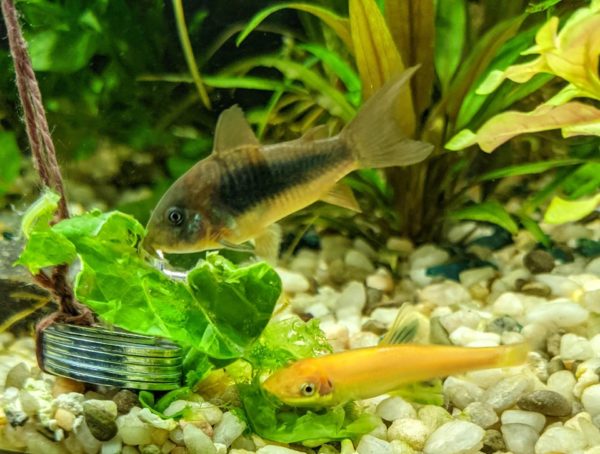
Fish that are similar in size or appearance to Chinese algae eaters and fish that swim near the bottom of the tank should be avoided when harboring Chinese algae eaters. Flat-bodied fish should also be avoided since Chinese algae eaters frequently attach their jaws to them.
The greatest tank mates for Chinese algae eaters are tiny, fast fish that live in the aquarium’s top levels, such as
- Mollies
- Platies
- Tiger barbs
- Clown loaches
- Cherry barbs
- Emperor tetras
- Dwarf gouramis
- Swordtails
- Zebra danios
Feeding Chinese Algae Eater
This species of fish nourishes, mostly with algae, but also accepts live or flaky food. Some vegetable delicacies, such as small cucumber pieces, should be added occasionally in the aquarium. This fish has been successfully reproduced in Captivity in fish breeders for consumption and marketed in specialized markets. In captivity, it has not been successfully breached in the aquarium, or there are no such well-documented and well-known successes to the general public. These fish reach sexual maturity at a length of about 12 cm or even greater.
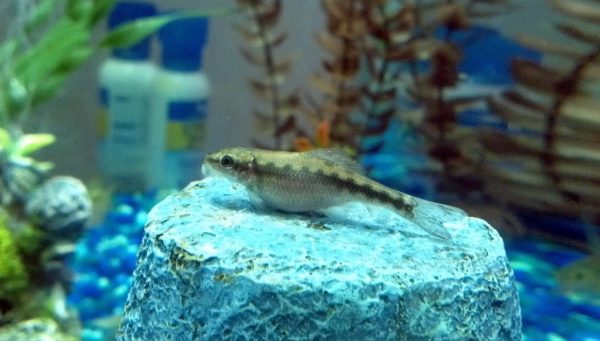
These fish eat algae, including red algae and any type of food found in commerce. It is very rare for them to eat aquarium plants, especially when they do not find any other plant food in the aquarium. CAE consumes the algae when they reach maturity, but it seems that they prefer to eat flakes once they mature.
What Should Be Given To Chinese Algae Eater As A Feed?
You can feed Chinese Algae Eaters algae and other vegetable matter diets in their younger stage. You can also consider supplementing it with tiny amounts of protein in flake and live meals. The fish will eat small crustaceans as they grow older and suck other fishes’ slime coats.
You can also give shelled peas, lettuce, spinach, diced fruits, cucumbers, frozen or fresh shrimp, bloodworms, and daphnia.
Feeding Frequency
The feeding frequency depends on the algae quantity growing in the tank. Feeding several times makes the algae perform well. You should give a small quantity of feed at a time to consume the food in very few minutes.
Breeding Chinese Algae Eater
Females are often fuller than males; however, sexing immature fish is practically difficult. However, when the male is getting ready to spawn, he develops characteristic tubercles on his snout. While there are no solid reports of Chinese algae eaters reproducing in home aquariums, some people have reared them in extremely large setups. Hormones are presently used for breeding them commercially on fish farms.
Follow the below instructions in breeding the Chinese Algae Eaters
- Create a separate breeding tank with a minimum capacity of 100 gallons, dim lighting, plenty of vegetation, good filtration, and a strong water flow.
- Place a healthy male and female in the breeding tank. To trigger spawning, raise the temperature of the water by two or three degrees per day until it reaches 82°F.
- Feed the fish a high protein, live or frozen food diet. Ascertain that all water criteria are met and that the water is clean. Replace 10% of the water daily.
- In a professional breeding system, the female should receive two hormone injections at this period. Wait several weeks to understand if the female Chinese algae eater is interested in spawning without hormonal interference.
- An interested female will deposit up to 3,000 eggs on the tank walls and leaves for the male to fertilize. If the female does not exhibit interest after a month, or if the pair starts fighting or displaying symptoms of hostility, remove the female and try again with another female.
- After the male has fertilized the eggs, remove the fish from the tank and return them to its home aquariums to prevent the parents from consuming the fry.
- A daily water change schedule should be maintained. Three days should be enough time to hatch.
- Feed the fry an algae-based diet until they are ready to be separated into their individual aquariums, which normally takes two to three months.
Nitrogen/other nutrient requirements for Chinese Algae Eater tank?
The nitrogen cycle in the tank of the Chinese Algae Eater is identical to that of any other fish aquarium. It is made up of the same biological processes that break down the hazardous by-products of fish, such as ammonia, into less toxic compounds (nitrites and nitrates) that can be easily removed from the water.
In poor water conditions with high ammonia and even nitrate concentrations.
As a result, before introducing any fish to the tank, make sure your filter has a fully developed bacterial colony. To keep the toxins under control, do partial water changes each week.
FAQ’s
Do We Face Any Difficulty In Handling The Chinese Algae Eater?
The Chinese sucker fish is suitable for novice and veteran aquarists, albeit with notable differences. Fish are typically purchased to combat algae in a tank. However, they grow to be huge and cannot tolerate fish of comparable size or look.
It also prefers clean water and is sensitive to the amount of nitrates in tank water. If you don’t keep the fish with other fish of the same species and the tank water is clean, the Chinese Algae Eater looks to be quite resilient and adapts well to various tank water conditions.
Things are a little different when it comes to immaculate cleaning of tank glassware and plants from algae fouling; if there isn’t anything else to eat, the fish are more inclined to clean themselves.
Is A Chinese Algae Eater Required For Aquarium?
Chinese algae eaters are resilient fish suitable for both novice and experienced aquarium keepers.
If you have enough space in your tank, a Chinese algae eater is a good choice. If you have a tank with fish similar in size or appearance to the Chinese algae eater, you should avoid getting one since it may cause hostility and territorial behavior.
Chinese algae eaters help control algae and minimize your cleaning obligations by cleaning the tank.
Chinese algae eater fish are a fascinating and amusing addition to a home aquarium despite their unattractive appearance.
Can We Keep Two Chinese Algae Eaters Together In An Aquarium?
Turtles don’t like fish of their species and size. So they will start fighting if placed together and will damage the tank ecosystem and environment. Hence similar species like Angelfish goldfish are not suggested tank mates.
Conclusion
Most aquarists are confronted at least once with the algae problem. Algae are needed in an aquarium; they help clean the aquarium’s water, oxygen the water, and even feed juvenile fish for adult fish that feed on plant matter. But if the algae problem gets out of control, the aquarium will have an unpleasant look, giving the impression of an unhealthy aquarium.
The Chinese algae eater is a famous fish species for its attitude, especially at an early age, because it eats filamentous and red algae.
For this reason, it is very popular among aquarists. Unfortunately, sometimes these fish are placed in aquariums without their respect; they must be kept in small groups, and in aquariums of at least 150 liters, they grow up to 27 cm.
It usually inhabits the area at the bottom of the rivers, but it moves into flooded forests in the rainy season. It feeds with algae, perifitone, and phytoplankton.
It is a fish full of life, which loves life in the group, it is recommended a 200-liter aquarium for small groups. You must cover the aquarium because it tends to jump out of the water.
No related posts.

1 thought on “Chinese Algae Eater: Complete Guide to Care, Breeding, Tank Size and Disease”
My algae eater had lots of babies in our aquarium at our home. I counted more than 40 babies but not really sure of how many total. The algae eater must have mated in April or May because I actually noticed the babies around June. I have been reading up on the mating but I am still new to all this. Our tank water is at 75. We have many other fish in there with them. I wasn’t sure if they were going to mate again or not but I never actually noticed the eggs or where they would have hid them. Anyways, we have lots of babies and it didn’t happen at the fish store because we’ve had them awhile and then they were hooking up together. Babies in Virginia ☺️ and they are doing Fantastic. They are now about roughly half in long and we just hit July.